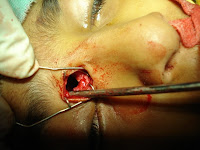










 Operative technique
Operative techniqueØ The cartilaginous part of the hump is incised first, either under direct vision using an Aufricht retractor, or by palpation.
Ø Using the widest osteotome that can be inserted (14 mm or 16 mm in most patients) reduces the risk of an uneven resection of the hump. Rounded ends of the cutting edge reduce the risk of skin perforations.
Ø Whenever possible, the cartilaginous and bony part of the hump should be removed in one piece.
Ø The cut edges of the nasal bone are smoothed with a rasp, preferrably with a tungsten-carbide tip. By sliding the wet index finger over the dorsum, irregularities and insufficient resections may be palpated and corrected.
Ø The nasal bones are mobilised cranially by paramedian oblique osteotomies with a 2 mm or 3 mm osteotome being inserted through the nostril of the opposide side. The osteotome is driven in a latero-cranial direction towards a point that lies approximately 1 cm medial and rostral to the medial canthus.
Ø For the lateral osteotomy, the osteotome is placed on the piriform crest at the level of the insertion of the inferior turbinate by perforating the skin parallel to the piriform crest and then rotating the osteotome by 90°. The osteotome is driven towards the end of the paramedian oblique osteotomy, staying as far lateral as possible. In most patients the osteotome will cleave the bone ahead of the osteotome connecting the two osteotomy lines well before the tip of the osteotome reaches the end of the paramedian oblique osteotomy. At this moment the palpating finger will feel that the nasal bone “gives in” and the pitch of sound of the mallet striking the osteotome changes from high to low. In the great majority of patients, the nasal bone is now sufficiantly mobile with the remaining persiosteum acting as a hinge keeping the lateral aspect of the mobilised nasal bone from falling medially. The index finger and thumb palpate the position of the osteotome.
Ø Bruising and swelling of the eylids can be reduced by moderate pressure over the osteotomy and immediate placement of a cast or splint with digital pressure maintained.























.jpg)
.jpg)

















